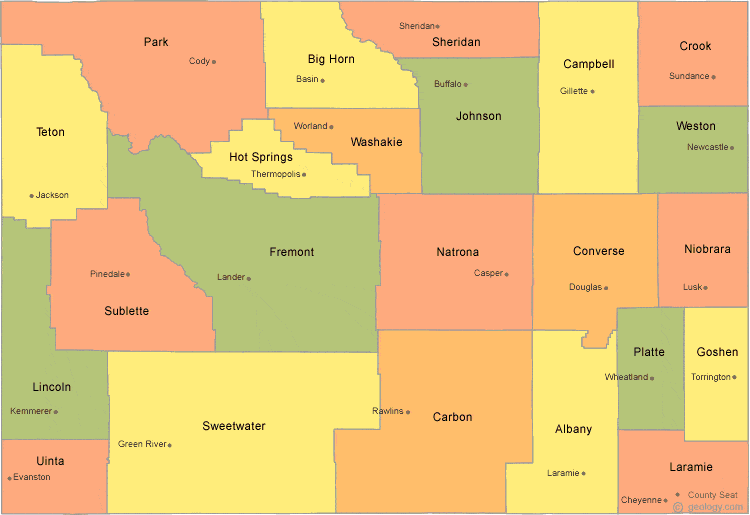Wyoming became the 44th state of the union on July 10, 1890. The land that became Wyoming had played an important part in developing the West. Settlers had traveled through the area to Oregon or California on the Oregon Trail and others. Mountain men had established lucrative trading posts for various beaver pelts, and when the railroad was developed, the Wyoming territory became an excellent place to raise cattle. Wyoming also has a rich native American history.

If you have an ancestor who settled in Wyoming, then keep in mind some of the events that were listed above. Were they frontiersmen, mountain men, Native Americans, or cattle ranchers? If you have ancestors who traveled to Oregon before the 20th century, then Wyoming may be a great place to search for various movements they may have made. They would have stopped along the way, and it is possible that they would have created records at the various rest points or forts.
| County | Date Formed | Parent County | County Seat |
|---|---|---|---|
| Albany | 1868 | Original five counties | Laramie |
| Big Horn | 1890 | Sheridan, Johnson, and Fremont Counties | Basin |
| Campbell | 1911 | Weston and Crook Counties | Gillette |
| Carbon | 1868 | Original five counties | Rawlins |
| Converse | 1888 | Albany and Laramie Counties | Douglas |
| Crook | 1875 | Albany and Laramie Counties | Sundance |
| Fremont | 1884 | Sweetwater County | Lander |
| Goshen | 1911 | Laramie County | Torrington |
| Hot Springs | 1911 | Fremont, Big Horn, and Park County | Thermopolis |
| Johnson | 1875 | Carbon and Sweetwater County | Buffalo |
| Laramie | 1867 | Original five counties | Cheyenne |
| Lincoln | 1911 | Uinta County | Kemmerer |
| Natrona | 1888 | Carbon County | Casper |
| Niabrara | 1911 | Converse County | Lusk |
| Park | 1909 | Big Horn County | Cody |
| Platte | 1911 | Laramie County | Wheatland |
| Sheridan | 1888 | Johnson County | Sheridan |
| Sublette | 1921 | Fremont and Lincoln County | Pinedale |
| Sweetwater | 1867 | Original 5 counties | Green River |
| Teton | 1921 | Lincoln County | Jackson |
| Uinta | 1869 | Original 5 counties | Evanston |
| Washakie | 1911 | Big Horn County | Worland |
| Weston | 1890 | Crook County | Newcastle |
Wyoming Genealogy: State and Local Records
When tracking an ancestor's life, it is important to locate vital records. Sometimes, it is as easy as searching an online database, and sometimes it can be harder. If you have located an ancestor who lived in Wyoming during its early statehood, it would be a good idea to contact the local historical and genealogical societies to see what type of information they may have. Locating records at the local level can be more precise and provide more information than those at the national level. Here are some places you may want to begin your search for local records:
- County Clerk’s Office: Contacting the county clerk can help you find some land records, court documents, and other interesting documents that will give you a deeper look into your ancestor’s life.
- Local Library: What were the newspapers during that time period? Most libraries have microfilm that will allow you to read what was going on during your ancestor’s life. Many libraries also have obituary collections.
- Local Genealogical Societies: Most counties have their own historical society and genealogical societies. It is quite possible that someone has come before you and done much of the research and has wrote it down. If that is the case, then a local genealogical society would have that document.
- Local Cemeteries: Finding the grave of your ancestor can also give additional clues.
Wyoming Genealogy: Online Resources
Here is a list of free and paid resources to track your Wyoming ancestor. Don't forget to check out some of the national parks I have listed, as they have been preserved by the government and may have records that you would not think about.
- Wyoming Compiled Census Index ( 1860 - 1910 )
- Wyoming Family Research Wiki Page
- Wyoming History - FamilySearch.org Wiki
- Historical Newspapers of Wyoming
- Wyoming Newspapers
- Wyoming Military Records
- National Park Foundation - Yellowstone National Park
- Oregon Trail through Wyoming
- Wyoming Historical Society
- Wyoming State Archives
- Wyoming Wills and Probate Records
Wyoming Libraries and Museums
- Wyoming State Library
- Campbell County Rockpile Museum
- Buffalo Bill Center of the West
- The Brinton Museum
- The DuBois Museum
- The Bank Museum
- The Bank Museum of Meeteetse
